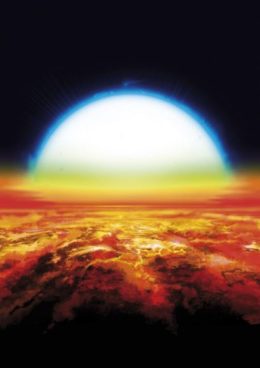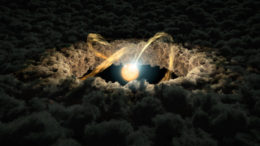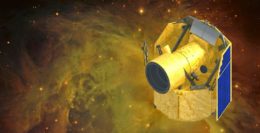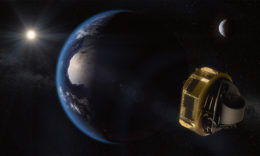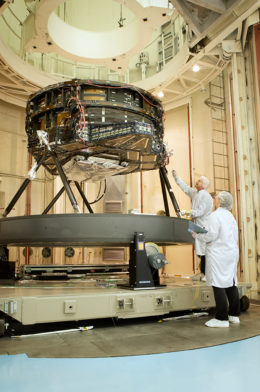Editor’s note: This is the final installment from last week, when we were in Reykjavik, Iceland at the Extreme Solar Systems (ExSS) IV meeting. Check out the previous four posts as well, to read more on the latest news from the field of exoplanet research!
Session 15: Atmospheres III
And we’re back for the last day of the conference and our third session on atmospheres!
Andy Skemer (UC Santa Cruz) opened the session by presenting the work of his graduate student, Brittany Miles, who was unfortunately unable to be here. Miles’s research has probed the atmospheres of some of the coldest brown dwarfs (the coldest, WISE 0855, is “250 K … so, colder than Iceland,” quips Skemer). Their spectra showed carbon-monoxide features that indicate the atmospheres of these cold bodies undergo strong mixing; this trend may continue down to even lower temperatures (e.g., planets).
The next several speakers took us to the opposite end of the temperature scale, discussing scalding ultra-hot Jupiters (with temperatures of >2,000 K).
- Lorenzo Pino (U Amsterdam; presenting on behalf of Jean-Michel Désert) showed how spectra from these planets have enabled a variety of measurements of the atmospheric composition and metallicities of ultra-hot Jupiters, paving a way forward to study these extreme bodies in the context of planet formation.
- Jens Hoeijmakers (U Bern) discussed the atmospheric composition of the especially extreme KELT-9b, which reaches more than 4,000 K on its dayside. Transmission spectra indicate its atmosphere contains heavy and rare-Earth metals (anybody need some yttrium?) — and new work suggests KELT-9b isn’t unique in this.
- David Ehrenreich (Geneva) showed how he and collaborators used the ESPRESSO instrument at the VLT — nominally designed to search for Earth-like planets — to explore the atmosphere of an ultra-hot gas giant. They find evidence for iron in the atmosphere on the dayside and evening of the planet, but it’s absent on the nightside and morning — which indicates that it may literally rain iron on this planet at night.
- Thomas Beatty (Arizona) dug deeper into ultra-hot-Jupiter clouds, describing observations that track the formation of clouds at the planet’s dusk and their destruction at dawn. He also presented observations that resolve a hot Jupiter’s atmospheric wind speeds as a function of longitude. These results show that we’re actually able to observe the weather on exoplanets — which is pretty awesome!
Melodie Kao (Arizona State) closed the session by zooming out and looking at the environment of atmospheres: their magnetospheres. One of the most direct ways to measure a planet’s magnetic field would be to observe exoplanet aurorae at radio wavelengths. So far, we haven’t yet achieved this — but Kao presented the next best thing: the first detection of an exo-aurora from a brown dwarf. This object is just 11–12 Jupiter masses; with any luck, exoplanet aurorae will be next!
Session 16: Disks
Next up, we got a closer look at the birthplaces of exoplanets: protoplanetary disks.
Catherine Espaillat (Boston U) provided a broad, multi-wavelength and multi-epoch view of a protoplanetary disk surrounding a young, dynamic host star. Her work shows the first observational evidence for a connection between these bright young stars, the accreting disk, and powerful jets ejecting mass from the system.The total mass of a protoplanetary disk and its ratio of solids to gas can influence how quickly planets form and what their compositions will be. Diana Powell (UC Santa Cruz) explored these properties by modeling a sample of disks, showing that disks are more massive than we’d previously appreciated (typically 9–27% the mass of the host star), and that ice formation in the outer, colder regions of the disk can alter its radial composition.

This ALMA image of the protoplanetary disk surrounding the star HL Tau reveals the detailed substructure of the disk, including gaps that may have been cleared by planets. [ALMA (ESO/NAOJ/NRAO)]
Disks aren’t always neat and well-behaved. Satoshi Mayama (SOKENDAI) showed us observations of a disk marred by symmetric shadows — shadows that we’ve guessed are cast by a tilted inner disk lying inside the outer disk’s cavity. Now, Mayama showed, we’ve made the first-ever direct detection of this inner gas disk with ALMA; modeling these observations confirms the inner disk is highly misaligned.
“This is beautiful, I’m having this painted on my living-room wall,” Thomas Esposito (UC Berkeley) joked as he presented a spectacular set of 24 high-resolution polarized intensity detections of debris disks made with GPIES. Debris disks are circumstellar disks of dust and debris thought to be left behind after a protoplanetary disk has cleared out the majority of its gas. Esposito outlined some of what the team has learned from these observations — which track the small dust of the systems — about young planetary-system environments.You can chalk another important detection up to ALMA: Virginie Faramaz (NASA JPL) presented on new observations of the faint debris disk that surrounds HR 8799, the only system in which multiple planets have been directly imaged. The ALMA observations constrain the inner edge of the disk, hinting at the presence of a fifth, as-yet-unseen planet in the system that’s carving the disk.
So if debris disks are what’s left after the primordial gas has been cleared out of a young planetary system, why have observations revealed the presence of gas in ~20 debris disks? Alexis Brandeker (Stockholm University) addressed this peculiarity as he explored these observations in the final talk of the session, which he gave on behalf of Quentin Kral (Obs Paris). This gas likely a secondary origin: it’s released when volatile-rich planetesimals collide with each other, forming the dust of the debris disk.
Session 17: Habitability and Biosignatures
This afternoon kicked off with an always exciting topic: where do we stand in the search for habitable planets and/or signs of life?
As we discussed yesterday, we expect that some white dwarfs should play host to exoplanets. Our primary evidence confirming this is the presence of pollutants in the outer laters of white-dwarf atmospheres, indicating that they’ve accreted planetary material from companions. Matthew Hoskin (Warwick) reported on detections of hydrogen in white-dwarf helium atmospheres, which allow us to infer the water content of the planetary bodies that we think these white dwarfs accreted.
The stars that have been identified as the best targets when looking for Earth-like planets lying in a star’s habitable zone are small, cool M dwarfs. A number of the talks in this session addressed these promising targets:
- Phil Muirhead (Boston U) summarized the results of multiple research programs exploring properties like rotation, magnetic fields, and metallicity of M dwarfs. We still have a lot to learn — for instance, there’s still an order of magnitude uncertainty in the amount of high-energy radiation bombarding M-dwarf exoplanets — but we’re making progress!
- Amber Medina (Harvard) provided further insight into M-dwarf activity. In her work, she measured the flare rates of all 0.1–0.3-solar-mass mid-to-late M dwarfs within 50 light-years observed by TESS. While faster rotators (P < 85 days) showed a high rate of energetic flares, slower-rotating stars (P > 100 days) showed little to no flaring activity — perhaps making these better targets in the search for life.
- Howard Chen (Northwestern) used a 3D chemistry-climate model to simulate tidally-locked exoplanets orbiting in the habitable zones of M and K dwarfs. Among his results, he found that only planets around active M dwarfs are susceptible to extreme ocean-loss; planets orbiting quiescent M dwarfs were able to hold on to their water content.
- Lisa Kaltenegger (Cornell) dove deeper into exoplanet oceans. Her recent work explores how oceans on M-dwarf exoplanets differ from Earth’s: since the stellar light peaks at a different wavelength, it penetrates to a different depth in the oceans — possibly around 100 times less deep! This should lead to enormous differences in water heating, ocean dynamics, winds, photosynthetic processes, and much more.
The earliest life presumably arose under quite harsh conditions on prebiotic planets — but there are some geochemical conditions that are needed to make the emergence of life possible. Dimitar Sasselov (Harvard) outlined a few of these necessities, like lots of hydrogen cyanide (for the C and N atoms) and ultraviolet light in the narrow 200–300 nm window.
Session 18: Future Missions
A perfect note on which to conclude the conference, the final session explored what’s next for exoplanet observational studies. TL;DR: we’ve got some seriously exciting exoplanet missions on the horizon!
Evgenya Shkolnik (Arizona State) opened the session by selling us on why small satellites (SmallSats, to those in the know) are awesome: they’re satellite missions that weigh 180 kg or less, and cost 1–2 orders of magnitude less than major space missions — yet they can do fantastic science! In particular, she described the SPARCS (Star-Planet Activity Research CubeSat) mission, a SmallSat that aims to launch in 2021 and will monitor M dwarfs in ultraviolet to provide valuable context for our search for biosignatures.
What’s next on the exoplanet front from Europe? Christopher Broeg (U Bern) reported that CHEOPS (CHaracterising ExOPlanets Satellite) is in-budget and on schedule to launch later this year! CHEOPS will observe the brightest host stars in the sky, watching the transits of super-Earths and Neptune-size planets. This small satellite is intended as a follow-up mission to complement future ground- and space-based surveys; it’ll observe one target at a time with ultrahigh-precision photometry, allowing us to make incredibly precise radius measurements for known planets.Andy Skemer (UC Santa Cruz) made his second appearance of the day, this time introducing the future of exoplanet imaging with upcoming extremely large telescopes (ELTs). ELTs will allow us to take photos of and characterize hundreds of gas-giant planets, dozens of Neptune-sized planets, and even a handful of rocky planets in reflected light and thermal emission. One example of upcoming capability is the Planetary Systems Imager, planned for use on the Thirty Meter Telescope (TMT).
Measurements of exoplanet masses and radii are important, but what about chemical composition? Göran Pilbratt (ESA/ESTEC) introduced ESA’s Atmospheric Remote-Sensing Infrared Exoplanet Large-survey (ARIEL) mission, which is designed to do one thing (and do it well): it will perform a detailed chemical census of the atmospheres of a large, well-constructed, diverse sample of transiting exoplanets orbiting F through M stars. ARIEL is scheduled for launch in 2028.Looking ahead to the James Webb Space Telescope’s (JWST) launch, scheduled for March 2021, Eliza Kempton (U Maryland) described how this long-anticipated infrared telescope will allow us to determine whether or not atmospheres are present on M-dwarf terrestrial planets. Kempton showed that JWST photometric observations of secondary eclipses (when the planet transits behind its host) could potentially distinguish between the presence or absence of an atmosphere in as little as a single eclipse.
Where does Wide-Field Infrared Survey Telescope (WFIRST) stand? This space telescope is still on target for a 2025 launch, reports Matthew Penny (Ohio State). If all goes according to plan, WFIRST will explore exoplanets in two ways: 1) it’ll conduct an exoplanet census via a large microlensing survey toward the galactic bulge, hunting for planets on orbits wider than 1 AU (as well as free-floating planets!), and 2) it will directly observe exoplanets with extreme contrast coronagraphic imaging and spectroscopy. The coronagraph instrument will serve as a proof of concept for technology for future missions, like LUVOIR and HabEX.We’ve talked about the future of transits, direct imaging, and microlensing — but what’s next for radial-velocity surveys? The final presentation of ExSS IV was given by Jennifer Burt (MIT), who gave us a road map for the next decade of extreme-precision radial velocity (EPRV) surveys. Burt outlined the capabilities of current and future EPRV surveys and discussed how they will help us to achieve goals like performing transit follow-up, exploring long-period architectures, and revisiting the closest, brightest, quietest stars to spot planets that we’d previously been unable to detect.
And with that, we’re done with ExSS IV! Congrats to all for a successful conference filled with some truly exciting science.
And for those of you following along at home: If you enjoyed reading about this meeting but feel like you want to hear more about science from our own solar system, check back in three weeks! I’ll be reporting from the EPSC-DPS Joint Meeting 2019 on planetary science in Geneva, Switzerland.


